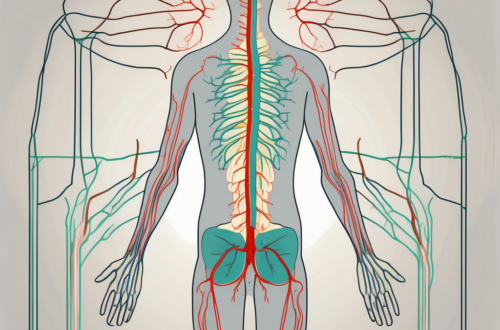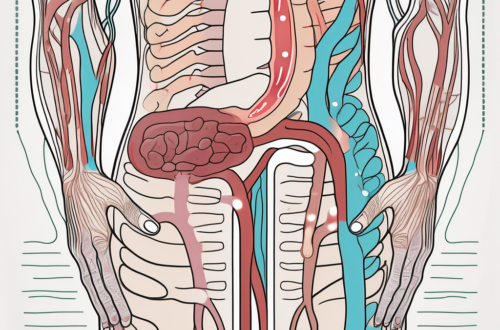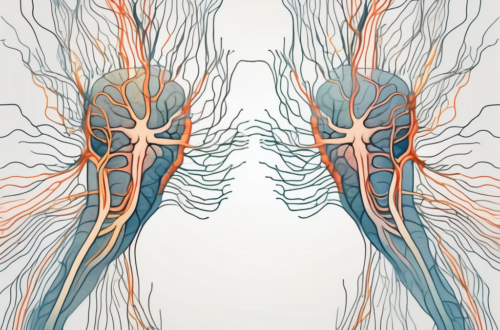In the intricate web of the human body, the nervous system plays a vital role in maintaining balance and harmony. Among its various components, the postganglionic parasympathetic nerve fibers hold great significance. Understanding these essential fibers is crucial for comprehending the intricate mechanisms that govern bodily functions.
Understanding Postganglionic Parasympathetic Nerve Fibers
Definition and Basic Function
Postganglionic parasympathetic nerve fibers are a crucial part of the autonomic nervous system. They serve as the final transmission pathway between the autonomic ganglia and target organs throughout the body. These unique fibers are responsible for transmitting signals that regulate involuntary bodily functions, ensuring the body’s efficient functioning.
The intricate network of postganglionic parasympathetic nerve fibers allows for precise control over various bodily processes. For example, these fibers play a key role in regulating heart rate, respiratory rate, digestion, and urinary function. By transmitting signals from the autonomic ganglia to the target organs, they facilitate the coordination and balance necessary for optimal bodily function.
Anatomy and Structure
Anatomically, postganglionic parasympathetic nerve fibers are characterized by their origin in the craniosacral region of the body. Emerging from cranial nerves III, VII, IX, and X, as well as the sacral region of the spinal cord, these fibers extend to numerous organs and tissues. They are intricately woven into the systems that maintain homeostasis, playing an influential role in both health and disease.
These nerve fibers form a complex network that branches out to reach various target organs. For instance, the postganglionic parasympathetic fibers originating from cranial nerve III, also known as the oculomotor nerve, innervate the muscles responsible for controlling the size of the pupil. This intricate connection allows for precise control over the amount of light entering the eye, ensuring optimal vision in different lighting conditions.
Similarly, the postganglionic parasympathetic fibers arising from cranial nerve VII, also known as the facial nerve, innervate the salivary glands, tear glands, and nasal glands. These fibers are responsible for stimulating the production and secretion of saliva, tears, and mucus, respectively. This ensures the proper lubrication and moistening of the oral and nasal cavities, aiding in digestion and maintaining the health of the respiratory system.
In addition to cranial nerves, postganglionic parasympathetic fibers also originate from cranial nerve IX, known as the glossopharyngeal nerve, and cranial nerve X, known as the vagus nerve. These fibers play a crucial role in regulating heart rate, gastrointestinal motility, and respiratory function. They ensure that these vital processes occur at the appropriate rate and intensity, allowing the body to adapt to various physiological demands.
Furthermore, postganglionic parasympathetic fibers originating from the sacral region of the spinal cord innervate the pelvic organs, including the bladder, reproductive organs, and lower gastrointestinal tract. These fibers are responsible for controlling urinary and bowel function, as well as sexual arousal and reproductive processes.
In summary, postganglionic parasympathetic nerve fibers are intricately connected to various organs and tissues throughout the body. Their origin in the craniosacral region and the sacral region of the spinal cord allows them to regulate a wide range of bodily functions. By understanding the anatomy and structure of these fibers, we can appreciate their vital role in maintaining homeostasis and overall well-being.
The Parasympathetic Nervous System
Overview and Function
The parasympathetic nervous system, often referred to as the “rest and digest” system, acts in contrast to the sympathetic nervous system. While the sympathetic system prepares the body for physical activity and stressful situations, the parasympathetic system engages during periods of rest, relaxation, and digestion. This intricate balance ensures proper bodily function.
When it comes to the parasympathetic nervous system, it is essential to understand its role in maintaining homeostasis. Homeostasis refers to the body’s ability to maintain stable internal conditions despite external changes. The parasympathetic system plays a crucial role in achieving this balance by regulating various bodily functions.
One of the primary functions of the parasympathetic system is to promote digestion. When we eat, our body needs to break down the food into nutrients that can be absorbed and utilized. The parasympathetic system stimulates the secretion of digestive enzymes and increases blood flow to the digestive organs, ensuring efficient digestion and absorption of nutrients.
In addition to digestion, the parasympathetic system also plays a vital role in cardiovascular activity. It helps regulate heart rate and blood pressure, ensuring that the cardiovascular system functions optimally. By slowing down the heart rate and dilating blood vessels, the parasympathetic system promotes relaxation and reduces stress on the cardiovascular system.
Furthermore, the parasympathetic system influences respiratory processes. It helps control the rate and depth of breathing, ensuring that the body receives an adequate supply of oxygen. By promoting relaxation and deep breathing, the parasympathetic system enhances oxygenation and supports overall respiratory health.
Relationship with Postganglionic Fibers
Postganglionic parasympathetic nerve fibers serve as the primary interface between the central nervous system and the parasympathetic system. They transmit signals that regulate a wide range of bodily functions, including but not limited to digestion, cardiovascular activity, and respiratory processes.
These postganglionic fibers originate from specific regions of the central nervous system, including the brainstem and the sacral spinal cord. From there, they extend to various target organs and release neurotransmitters that elicit specific responses in those organs.
For example, in the digestive system, postganglionic parasympathetic fibers release acetylcholine, a neurotransmitter that stimulates the secretion of digestive enzymes and increases intestinal motility. This ensures efficient digestion and absorption of nutrients.
In the cardiovascular system, postganglionic parasympathetic fibers release acetylcholine, which binds to receptors on the heart, causing a decrease in heart rate. This helps to regulate heart rate and maintain a steady rhythm, preventing irregularities and promoting cardiovascular health.
Similarly, in the respiratory system, postganglionic parasympathetic fibers release acetylcholine, which acts on receptors in the airways, causing smooth muscle relaxation and bronchodilation. This allows for easier airflow and optimal oxygenation of the body.
Overall, the relationship between postganglionic parasympathetic fibers and the parasympathetic system is crucial for maintaining proper bodily function. These fibers serve as messengers, transmitting signals that regulate various physiological processes, ensuring that the body can rest, digest, and function optimally.
Role in Bodily Functions
The impact of postganglionic parasympathetic nerve fibers on the digestive system is immense. Through their intricate network, these fibers stimulate the secretion of digestive enzymes, increase blood flow to the digestive organs, and promote peristalsis, facilitating the breakdown and absorption of nutrients. Their influence helps maintain optimal digestive health, ensuring that the body receives the nourishment it needs.
Furthermore, the postganglionic parasympathetic nerve fibers also play a role in the regulation of gastrointestinal motility. By coordinating the contraction and relaxation of the smooth muscles in the digestive tract, these fibers help propel food through the various stages of digestion. This intricate coordination ensures that the food is properly broken down and absorbed, preventing any digestive issues or discomfort.
Cardiovascular System
Postganglionic parasympathetic nerve fibers play a crucial role in regulating cardiovascular function. Through their innervation of the heart, they slow the heart rate, reduce blood pressure, and improve overall cardiovascular efficiency. This delicate balance supports a healthy circulatory system.
In addition to their effects on the heart, these nerve fibers also contribute to the regulation of blood vessel diameter. By causing the blood vessels to dilate, they increase blood flow to various organs and tissues, ensuring that they receive an adequate supply of oxygen and nutrients. This regulation of blood vessel diameter is essential for maintaining optimal cardiovascular health and preventing conditions such as hypertension.
Respiratory System
In the respiratory system, postganglionic parasympathetic nerve fibers contribute to the regulation of bronchial smooth muscle tone, mucus production, and airway constriction. Their activity helps maintain optimal lung function and facilitates the exchange of oxygen and carbon dioxide.
Moreover, these nerve fibers also play a role in the regulation of respiratory rate. By influencing the contraction and relaxation of the muscles involved in breathing, they help ensure a smooth and efficient exchange of gases in the lungs. This coordination of respiratory rate and lung function is crucial for maintaining proper oxygenation of the body’s tissues and removing waste gases.
Additionally, the parasympathetic nervous system also plays a role in the regulation of coughing and sneezing. These protective reflexes help expel foreign particles and irritants from the respiratory tract, ensuring its cleanliness and preventing respiratory infections.
Impact on Health and Disease
The role of postganglionic parasympathetic nerve fibers in health and disease is a fascinating area of study. These fibers, which are part of the parasympathetic division of the autonomic nervous system, have been implicated in various neurological and cardiovascular disorders.
Role in Neurological Disorders
One area where postganglionic parasympathetic nerve fibers have been found to play a significant role is in neurological disorders. Dysregulation of these fibers has been linked to conditions such as migraine headaches, dysautonomia, and even gastrointestinal disorders.
Migraine headaches, characterized by severe throbbing pain, are often accompanied by autonomic symptoms such as nausea, vomiting, and sensitivity to light and sound. Research suggests that the dysfunction of postganglionic parasympathetic nerve fibers may contribute to the development and severity of migraines.
Dysautonomia, a condition characterized by dysfunction of the autonomic nervous system, can also be influenced by the activity of postganglionic parasympathetic nerve fibers. Symptoms of dysautonomia can include abnormal heart rate, blood pressure fluctuations, and gastrointestinal issues. Understanding the intricate connection between the nervous system and these disorders is essential for effective diagnosis and management.
Influence on Cardiovascular Diseases
Postganglionic parasympathetic nerve fibers have also been found to have an influence on cardiovascular diseases. Cardiovascular diseases encompass a wide range of conditions affecting the heart and blood vessels, and understanding the role of these nerve fibers is crucial for advancing our knowledge in this field.
Arrhythmias, abnormal heart rhythms, are one cardiovascular disorder where postganglionic parasympathetic nerve fibers have been shown to play a role in the pathophysiology. These fibers can modulate the heart rate and rhythm, and their dysregulation can contribute to the development of arrhythmias. Research in this area continues to shed light on potential therapeutic targets for managing and treating arrhythmias.
Heart failure, a condition where the heart is unable to pump blood effectively, is another cardiovascular disorder where postganglionic parasympathetic nerve fibers have been implicated. The activity of these fibers can affect heart rate, cardiac contractility, and blood vessel dilation, all of which are important factors in heart failure. Understanding the intricate mechanisms involved in the interaction between these nerve fibers and the cardiovascular system is crucial for developing targeted therapies.
In conclusion, postganglionic parasympathetic nerve fibers have a significant impact on health and disease, particularly in neurological and cardiovascular disorders. Further research in this field is essential for unraveling the complex connections between the nervous system and these disorders, ultimately leading to improved diagnosis and management strategies.
Current Research and Future Directions
Understanding the intricate workings of the human body is an ongoing endeavor that constantly expands our knowledge. One area of particular interest is the study of postganglionic parasympathetic nerve fibers. These fibers play a crucial role in regulating bodily functions and have been the subject of extensive research in recent years.
Advances in Neuroscience
Thanks to advances in neuroscience, our understanding of postganglionic parasympathetic nerve fibers has reached new heights. Sophisticated imaging techniques, such as functional magnetic resonance imaging (fMRI) and positron emission tomography (PET), allow researchers to visualize the activity of these fibers in real-time. This invaluable tool provides insights into their function and connectivity within the nervous system.
In addition to imaging techniques, genetic research has also contributed significantly to our understanding of postganglionic parasympathetic nerve fibers. By studying the genes that govern the development and function of these fibers, scientists have uncovered important molecular mechanisms that underlie their role in maintaining bodily homeostasis.
Furthermore, advancements in neurophysiology have enabled researchers to explore the electrophysiological properties of postganglionic parasympathetic nerve fibers. By recording the electrical signals generated by these fibers, scientists can gain a deeper understanding of their firing patterns and how they contribute to the overall functioning of the autonomic nervous system.
Potential Therapeutic Applications
The detailed understanding of postganglionic parasympathetic nerve fibers opens up exciting avenues for potential therapeutic applications. Targeting these fibers may provide new approaches for the management of various disorders.
One area where these therapeutic applications show promise is in the treatment of irritable bowel syndrome (IBS). By modulating the activity of postganglionic parasympathetic nerve fibers that innervate the gastrointestinal tract, researchers hope to alleviate the symptoms associated with this condition, such as abdominal pain, bloating, and altered bowel habits.
Hypertension, or high blood pressure, is another condition that could potentially benefit from targeting postganglionic parasympathetic nerve fibers. By regulating the activity of these fibers, researchers aim to achieve better control over blood pressure levels, potentially reducing the risk of cardiovascular complications.
Dysautonomia, a disorder characterized by dysfunction of the autonomic nervous system, is yet another condition that may benefit from advancements in this field. By understanding the role of postganglionic parasympathetic nerve fibers in autonomic regulation, researchers hope to develop targeted therapies that can restore normal functioning in individuals with dysautonomia.
It is important to note that while these potential therapeutic applications hold promise, any treatment should be discussed with a healthcare professional. Each individual’s condition is unique, and a personalized approach is necessary to ensure the best possible outcome.
In conclusion, the role of postganglionic parasympathetic nerve fibers in maintaining bodily function is undeniable. Through their innervation of various organs and systems, these fibers ensure the body operates smoothly. Ongoing research and advancements in neuroscience offer promising insights into their potential therapeutic applications. Embracing the complexities of these fibers will continue to deepen our understanding of human physiology and pave the way for innovative approaches to healthcare.





